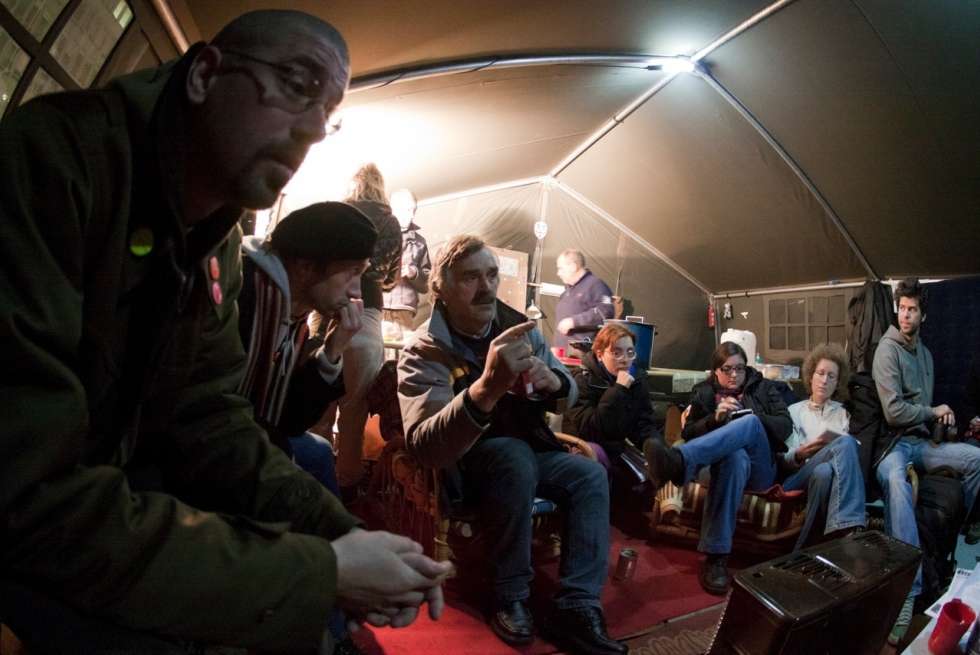Israel's “Tent Protests:” A Domesticated Mobilization
From the Series: Occupy, Anthropology, and the 2011 Global Uprisings
From the Series: Occupy, Anthropology, and the 2011 Global Uprisings

The Israeli Tent Protests came and went over a space of three months between July and September 2011. The protests started when Dafni Leef, a freelance video editor from Tel-Aviv, pitched a tent on Rothschild Boulevard in the city center after her landlord informed her that her rent would be going up beyond her means. Leef created a Facebook event for her protest and was joined by several friends. Within 24 hours dozens of tents were standing on the grassy sidelines of the promenade and over the coming fortnight more than 50 encampments appeared in almost every Israeli town and city. Initially sparked by high housing prices, the protests' agenda widened to encompass Israel's high cost of living, and calls for a return to the old welfare state were widely heard. It was doubtlessly the largest protest wave in Israel's history, with 400,000 people participating in the last large demonstration and polls indicating up to 87% public support.
Yet compared to similar events around the world, the Israeli tent cities were perhaps the tamest actions in the current global wave of protest. Not only did calls for discrete welfare policies replace any explicit anti-capitalism, but there was also a widespread insistence on the movement's “apolitical” nature and an avoidance of direct confrontation with the Netanyahu government or calls for new elections. Instead, protest leaders repeatedly expressed a desire for the current government itself to solve the country's social problems and to somehow abandon its own neoliberal ideology.
One explanation for this dynamic is that radical messages were eschewed in order to keep the movement broad. But a more substantive one follows from the fact that the movement saw very little public discussion of the country's bloated security budget or the financing of settlements in the West Bank as factors in the lack of spending on education, welfare, and social services. What was at work in keeping the Israeli movement so tame was the chilling effect of the patriotic, state-loyalist discourses that have reached unprecedented prominence in Israeli society in the past few years. Indeed, the movement is best understood as an all-too-brief interlude in Israel's ongoing move away from democracy, evident in the recent wave of legislation against minorities, refugees, and human rights organizations and in the McCarthyist campaigns against opponents of the occupation in academia and civil society. This public atmosphere led movement participants to avoid at all costs being perceived as “Leftists”—a term which in Israel these days is all-but synonymous with “traitors”—and created deliberate self-censorship that not only silenced any engagement with the Israeli-Palestinian conflict, but also defused confrontation on socio-economic grounds.
The protests also displayed a strange mix of democracy and centralism. Alongside popular assemblies and direct democracy in the protest encampments, Leef and her friends—who had been crowned by the mainstream media as the movement's leaders—maintained an unaccountable stance towards the grassroots. The second week of the protest already saw significant dissatisfaction with their eagerness to monopolize the movement's public expression. At a crisis point in this confrontation, a number of participants (including the author) convinced the founders to participate in a national assembly with tent-city representatives from around the country. The participants unanimously decided to elect from within a strictly mandated national steering committee. Yet on the advice of their spin-doctors, Leef and her friends stopped convening the forum after its first meeting, and the encampment representatives were never involved in decision making. The reaction to this move was the growth of autonomous organizations such as the "Periphery Forum" and the “Northern Front," coalitions of encampments on a class or regional basis that began to operate jointly and in isolation from the media-designated national leadership.
Perhaps the internal structure of the protests would have been more democratic had the founders of the struggle possessed more political experience. Yet most of them were young media workers who saw media reporting as the most important arena of struggle, entering into a frantic pace of engagement with corporate journalists where consultation with the grassroots seemed a luxury. At the same time, it is doubtful whether any measure of political experience would have managed to sustain a movement that was both large-scale and politically radical. Israeli society's siege mentality and intolerance for disloyalty simply left no space for that.
As I write this, activists are preparing to relaunch protests with a demonstration in Tel Aviv under a minimalist banner of nonviolence and “open source” organizing. Expectations that a new round of mobilization would coincide with the election season have been thwarted by the government, which has signed a new coalition agreement with the main opposition party. The centerpiece of their promises: conscription into the army of ultra-orthodox Jews, a step blatantly intended to placate the secular public's concerns about the unequal burden of service by further entrenching militarism. Polls also indicate that despite the protests and general cynicism about the political class, the right-wing camp is as strong as ever. Once again, in this "barracks society" the Pavlovian reflex of securitism in the face of a perceived existential threat overpowers any agenda for social justice.
Uri Gordon is an Israeli environmental and peace activist, and a writer on radical political theory. He is the author of Anarchy Alive! (Pluto Press, 2008), and several articles on contemporary anarchist politics.